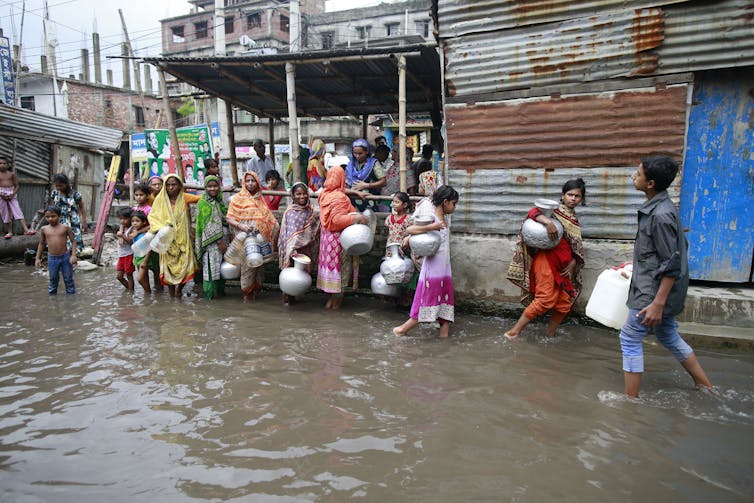 |
| Listen! Andy Rain/EPA |
The resulting tsunami hit the global economy and public sector, discrediting finance and its attempts to extract large rents from every aspect of the economy, including housing and food. An alternative was urgently needed.
Ten years later, private finance and large investors will play a central role at the COP24 in Katowice, Poland, and in the full implementation of the 2015 Paris Agreement.
Representatives from pension funds, insurance funds, asset managers and large banks will attend the meeting and lobby governments, cities and other banks to favour investments in infrastructure, energy production, agriculture and the transition towards a low-carbon economy.
Has finance cleaned up its act?
There is a US$2.5 trillion gap in development aid which needs to be filled if poor countries can adequately mitigate the effects of climate change. With little enthusiasm among rich countries to stump up, the role of private finance is inevitable. Policy makers trust financial capital as our best hope of securing investment to avoid the catastrophic warming beyond 1.5°C.This has been the case for a while – the first announcement came at the UN Climate Summit in 2014, when a press release on the UN website said the investment community and financial institutions would “mobilise hundreds of billions of dollars for financing low-carbon and climate resilient pathways”.
Since then, networks that stress the role of private finance in rescuing the planet have multiplied, including the Climate Finance session at the Sustainable Innovation Forum, which will also take place in Katowice, on December 9-10 2018.
It is difficult to ignore that a strong reliance on private finance means putting the future of Earth in the hands of individuals and institutions that brought the global economy to the verge of collapse. It may be partially true that some are divesting from fossil fuels and funnelling their money into better projects. But before we pin our hopes on finance to solve climate change, there are some things we need to ask ourselves.
 |
| Poor countries like Bangladesh have little responsibility for climate change and need significant investment to adapt to it. Suvra Kanti Das/Shutterstock |
Difficult questions for COP24 negotiators
How did we get to a point in history where it is taken for granted that public money alone can never be sufficient to finance our transition from fossil fuels? Is it an objective condition with no clear causation and responsibility, or something else?What about the fact that global military spending in 2017 reached US$1.7 trillion while poor countries promised funding for climate change adaptation and mitigation in 2015 are still waiting?
Read more: COP24: climate protesters must get radical and challenge economic growth
What about the cost of bailouts to the financial sector, which in the UK alone has been estimated at US$850 billion? As Michael Lewis noted in his boomerang theory, states that have propped up financiers with public money are now asking those same financiers to step in and do the job that states should do. And this leads to the second consideration.
Climate change is historically, politically and socially complex. Although sustainable finance is not presented as the sole solution, analysing its role produces a series of strategic short circuits.
Read more: Climate change and migration in Bangladesh -- one woman's perspective
It oversimplifies and depoliticises the response to climate change. It legitimises the idea that sustainability can be achieved within continuous growth and expansion, which are essential to the survival of the financial sector.
It rewrites the way we think about our planet in the vocabulary of finance and its obsession for a return on investment. It marginalises any claim to address climate change based on present and historical injustices, redistribution and bottom-up projects organised by ordinary people.
It accepts that the financial way of defining sustainability and its achievements are inherently aligned with the rights, interests and needs of people and the planet.
Finance may be a partner in the fight against climate change, but it is certainly not a partner motivated by altruism. It’s motivated by generating profit from the transition. It is therefore unsurprising that energy generation, railways, water management and other forms of climate mitigation have been identified as priorities for sustainable finance.
 |
| Action on climate change has to involve standing up to the Wall Street Bull. Quietbits/Shutterstock |
Fighting climate change on Wall Street’s terms
Wall Street can find large returns by investing in the transition to “greener” infrastructure, including the not-so-green Chinese green belt and road and dams like the Belo Monte, a project that originally applied for carbon credits and was labelled as a sustainable investment. Green bonds can help cities finance projects to reduce their environmental impact or adapt to climate change.However, if money is the driver, we should not expect private investors to have any interest in projects that won’t generate a sufficient return, but would benefit people or cities that cannot pay for the service or for the debt, or that would protect vulnerable people from climate change. If climate change is fought according to the rules of Wall Street, people and projects will be supported only on the basis of whether they will make money.
Ten years ago, the world saw that finance had permeated every aspect of the global economy. Back then, it was clear that financial interests could not build a better and different world. Ten years later, COP24 should not legitimise large financial investors as the architects of a transition where sustainability rhymes with profitability.
----------------------------
This blog is by Cabot Institute member Tomaso Ferrando, a Lecturer in Law at the University of Bristol. This article is republished from The Conversation under a Creative Commons license. Read the original article.
